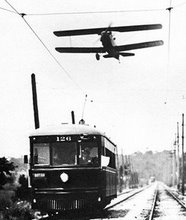MARYLAND TRANSIT PLANNERS BUST BRT MYTH MAKERS
Light Rail Trumps Bus Rapid Transit
Thursday, July 24, 2008;
Light Rail Trumps Bus Rapid Transit
Thursday, July 24, 2008;
The June 29 Commuter page [Metro section] featured a status report on Maryland's Purple Line transit project, in which I listed some of the arguments for and against the system, which could be light rail or bus rapid transit.
Dear Dr. Gridlock:
Your report on the Purple Line was very disappointing. Almost everything you said was true, but what you left out was all important for public understanding.
One erroneous statement is that bus rapid transit is just like light rail but on rubber tires. Light rail runs on domestic, low-cost electricity. Bus rapid transit runs on high-cost foreign oil. That is bad and costly.
Buses last only 12 years, while light rail cars last 40 years. In ice and snow, light rail has guidance and braking. Buses do not, unless the roadway is cleared and salted, polluting streams.
On open right-of-way, light rail absorbs water, but busways need extensive water runoff provisions to prevent damage. Light rail cars are larger than buses for comfort, efficiency and safety.
Bus size is limited by highway laws and clearances. The light rail ride is smoother and faster. Rails have no potholes, and electricity provides more power for acceleration.
If we want clean air, less foreign oil, lower long-term costs and more transit use, we must think about those differences.
Critics who say the Purple Line will not relieve congestion are wrong. It's true that one rail transit line will not solve the metro area's traffic problems overall, but it sure will help the local area.
Consider: Estimates suggest the line will have 3,000 riders per peak hour one-way at key points, such as 16th Street and Piney Branch Road. It would take four traffic lanes on streets with traffic signals to move 3,000 people per hour in vehicles with 1.15 people each. Four more lanes of capacity each way will help traffic greatly.
Vienna
Makes sense to me. Like Tennyson, a transportation consultant and former deputy secretary of transportation for Pennsylvania, I hope the Maryland Transit Administration will favor light rail over bus when it issues its findings later this year.
It's difficult to see the decision going any other way. Supporters in and out of Maryland government have been touting the latest ridership figures, which suggest the line would record 68,000 daily trips between Bethesda and New Carrollton. That's for a high-end investment in light rail estimated by planners at up to $1.75 billion for the 16-mile route.
Why No Cross-Town Buses?
Dear Dr. Gridlock:
Why isn't there bus service directly from Maryland to Virginia?
I live in Gaithersburg and work in Tysons Corner, so my public transportation options involve a trip through the District.
Am I the only one of the thousands of people who cross the American Legion Bridge each day who would rather take a bus?
Jon Freilich
Gaithersburg
This is an excellent idea. When he was Montgomery County executive, Douglas M. Duncan felt the same way. Trouble was, not enough commuters did. The SmartMover took commuters from points along the Interstate 270 corridor to Tysons, via the American Legion Bridge. But it failed for lack of ridership, given the high operating costs.
There were plenty of reasons for the failure. Buses got stuck in traffic, schedules became unreliable and once riders got off at the bus station in Tysons, it was difficult to walk to work across those wide, heavily traveled boulevards.
This noble experiment is not an idea that Maryland and Virginia can afford to dismiss. Not today, with construction of new lanes underway on the western side of the Beltway, with the Metrorail project at Tysons and with the planned rebuilding of Tysons itself.
Taking drivers off the road by giving them a new bus option will look smarter and smarter.
HOV - Bus Rapid Transit Highway Enforcement
Over the past two months, enforcement of the rules for High Occupancy Vehicle lanes has been one of the top five topics in the mailbag. There's a lot of anger out there.
I travel the Interstate 66 HOV lanes and notice that although police cars monitor many of the entrances and exits between the Capital Beltway and the District, HOV violators who travel to and from outside the Beltway have relative impunity.
Occasionally, I'll see someone stopped. While that driver is being ticketed, several others go by.
Why is there no way of reporting violators? I know that many people don't understand hybrid rules and that some cars have toddlers tucked where you can't see them. But I think a compilation of reported violators could be used to supply an aggravating factor if they are ever ticketed.
Also, there are predictable times when I-66 comes to a virtual crawl: accident, snow or, most predictably, sunshine (at very specific locations). State police could sit at those spots and stop violators much like shooting fish in a barrel.
Although I very much support enforcement -- especially those conducted on the HOV ramps, where it's safest -- police and commuters understand that enforcement itself creates congestion.
If I want the mailbag to bulge with irate letters, I should urge police to set up an HOV enforcement zone near an accident scene during a snowstorm.
Maura McMahon





















No comments:
Post a Comment